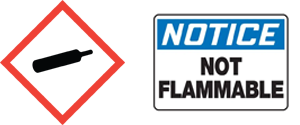About Argon Gas
- Type of Gas
Classification: Inert gas used primarily as a shielding gas in welding processes.
- Gas Properties
Flammability: – Non-flammable and non-toxic.
Density: – Heavier than air, which can affect how it disperses in the welding environment.
Purity: – High purity argon is essential for optimal welding results to prevent contamination.
- Equipment and Setup
Gas Cylinders: Proper handling, storage, and transportation of argon cylinders.
Regulators: – Set and adjust argon pressure correctly to match welding specifications.
Hoses and Fittings: – Ensure compatibility and check for leaks before use.
- Welding Techniques
Welding Processes: – Commonly used in TIG welding; also applicable in MIG welding with argon mixtures.
Flame Adjustment: – Not applicable since argon is inert, but knowledge of flow rates is essential for shielding.
- Safety Practices
Personal Protective Equipment (PPE): – Use gloves, goggles, and flame-resistant clothing.
Ventilation: – Ensure good ventilation to prevent argon buildup in confined spaces.
Fire Safety: – While argon is non-flammable, ensure that other materials present are safe.
- Weld Quality and Techniques
Weld Characteristics: – Argon provides a stable arc and clean welds with minimal oxidation.
Common Defects: – Awareness that insufficient shielding can lead to contamination and poor weld quality.
- Application Knowledge
Material Types: – Effective for welding non-ferrous metals like aluminum and titanium, as well as stainless steel.
Welding Positions: – Learn and understand how argon behaves in different positions and environments.
-
- Regulatory Compliance
Safety Standards: – Follow OSHA and other relevant standards for gas handling.
Certification Requirements: – Recommended certification or training using TIG and MIG welding processes with argon.
Additional Information
- Chemical Symbol:
- Argon Chemica Symbol – Ar
- Atomic Number: 18
2. Safety Consideration and Labels
Note: – Argon is classified as a non-toxic, inert gas, but it can displace oxygen in the air.
Recommended Safety Labels:
Non-Flammable: No flame symbol is required since argon is not flammable.
Asphyxiant Warning: A label indicating it can cause suffocation by displacing oxygen in confined spaces.
GHS (Globally Harmonized System) Labels: – Argon may carry a GHS label. The Argon a GHS label is the “Gas Cylinder Icon” which indicates that the gas is stored under pressure.
No Specific Health Hazard Icons: – Since it’s non-toxic, but it may include a warning for potential asphyxiation.

Gas Cylinder Icon and OSHA Not Flammable Notice
Gas Specification Sheets
PurityPlus – Common Specialty Gases – Argon
PDF Download
Pure Gas Grade Specifications
PDF Download
